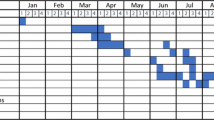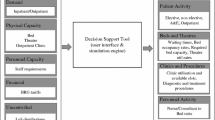Abstract
In this study we used a nonparametric statistical approach estimate time varying arrival rates to an Emergency Department (ED). These rates differ hourly within each month in a year. The time varying arrival rates serve as a key input into a new discrete-event simulation model for patient flow at an ED of the case study hospital. Our simulation model estimated Length of Stay (LOS) and Door to Doctor Time (DTDT) for patients in three different acuity groups. The simulation model also used for optimizing the staffing allocations in three different shifts. The methodological contributions are exemplified using real ED data from a major teaching hospital.
Access provided by CONRICYT-eBooks. Download conference paper PDF
Similar content being viewed by others
Keywords
1 Introduction
Hospital emergency departments (EDs) are one of the most critical elements of the national health system in the United States. According to the US Government Accountability Office (GAO) report, hospital ED crowding continues to increase wherein some patients wait longer than the recommended times [1] thereby receiving poor quality of service [2].
A commonly used performance measure for evaluating ED operations is Length of Stay (LOS) defined as the time between the arrival to discharge of a patient from an ED. Another measure is Door to Doctor Time (DTDT), i.e., the time difference between arrival at an ED and the time a physician first sees the patient. LOS generally consists of the sum of two components (a) processing times which are related to patient acuity involving triage, physician examination, laboratory tests, medical treatment; and (b) patient waiting times for reaching these processes, often called process queue times. In some cases, LOS could be high for admitted patients due to boarding, or some patients could be held in ED until their conditions are stabilized. DTDT could be a more critical performance indicator for immediate and critical patients due to the severity of their medical conditions. In the estimation of DTDT and identification of operational strategies that could improve this measure, acuity levels of patients should be taken into account, rather than taking the average DTDT to increase service quality. Ang et al. [3] used a Q-lasso method that combines statistical learning and fluid model estimators to predict ED wait times for different patient acuity groups. Kuang and Chan [4] evaluated proactive patient diversion policies by using predicted waiting time information to improve service quality at an ED. Similar methodological approaches of integrating predictive modeling with simulation were used by Saghafian et al. [5] in order to develop patient streaming policies and sequencing to improve ED service responsiveness.
In this research we first present the analyses of patient arrivals data to an ED to better parametrize a discrete event simulation model then using simulation optimization in Arena software [6] we allocate the staff optimally in three shifts for staff balancing. Althoguh there are extensive studies in the literature using queuing theory principles and simulation-optimization approaches for EDs, most of them do not consider seasonal or monthly variations in patient arrival rates. Saunders et al. [7], Duguay and Chetouane [8], Kuo et al. [9] presented discrete event simulation models for process flow of EDs and used simulation experiments for assessing ED performance are some examples.
2 Patient Flow
Patient flow in the ED of the case study hospital involves triage, physician examination, extra testing, nurse evaluation, minor treatment and major treatment operations, and patient stabilization times. Patients arriving at the ED are evaluated at the triage then categorized and prioritized according to their medical condition wherein the acuity levels range between 1 (most critical) and 5 (least critical). If a patient arrives to the ED as a walk-in, acuity level ranges between 2 and 5 most of the time. However, if patients arrive in an ambulance, they could skip triage and are considered acuity 1. All patients are examined by a physician based on the priority rule that accounts for acuity level in the examination room. Physicians direct some patients to a test room to have their tests completed, following which they revisit the physician for assessment. Patients could follow different routes after the physician’s assessment; these routes along with routing probabilities are presented in Fig. 1 based on 2014 ED visits data that was exported from the hospital’s database. Total ED visits during that calendar year was 49,180—1% acuity 1 patients, 11% acuity 2, 52% acuity 3, 30% acuity 4, and 6% acuity 5.
3 Simulation Model
We developed a discrete event simulation model to analyze the patient flow in the ED based on Fig. 1. The following discussion details each of the key inputs to be used in the overall discrete-event simulation model.
Service (Processing) Times: The required service times for processes in the ED include, examination time, extra test time, nurse evaluation time, major and minor treatment times. We estimate these times from the hospital data and used feedback from experts for verification purposes. As discussed in Kuo et al. [9], service times do not have a consistent structure due to the urgency in any ED; hence it is difficult to use statistical methods to estimate each of the service steps in the ED flow. The staffing included physicians who are scheduled daily, lab technicians, (scheduled only for week days), and nurses who are scheduled for a week. We estimated the triage processing time from ED data as the average time patients spent from initial arrival to the ED until completion of triaging at the nurses’ station. The other processing times are estimated based on interviews with ED staff, and are presented in Table 1. Given the inherent uncertainty in these data, we model them using probability distributions that allow for considerable and realistic variability in these input parameters.
Routing Probability: The routing probabilities are directly related to patient acuity level in the ED. Using the hospital’s data these probabilities were calculated as detailed in Fig. 1.
3.1 Time-Varying Poisson Arrival Rates
A Poisson distribution was fit to hourly arrivals data from which time varying hourly arrival rates in a day were obtained: we have 24 parameters, \(\hat{\lambda }\left( t \right)\), (t = 1,…, 24), and these are shown in Table 2. The distinction between these Poisson time-varying rates and the ones detailed under time-varying rates is that no distribution assumption is made in the latter. This, we believe, may be useful in this context since, there’s considerable variability in the observed data that is quite difficult to fit using a parametric model.
3.2 Model Validation
To ensure that the model is a valid representation of real ED, we compare the real patient arrivals with the simulated patient arrivals. While real data contain 48,140 patient records, simulated data generated 45,688 patients.
In addition we analyzed the observed LOS and simulated as presented in Fig. 2 to compare the distributions of both real and the simulated LOS. The simulated LOS’s mean is 245.46 min and its standard deviation (SD) is 144.88 min and observed mean of LOS is 243.81 min (SD = 148.49 min). We performed the following hypothesis for testing whether they come from the same statistical distribution or not.
Hypothesis
-
H0: Observed length of stay (LOS) and the simulated LOS follow same statistical distribution.
-
H1: Observed LOS and the simulated LOS do not follow same statistical distribution.
Since both real LOS and simulated LOS distributions do not fit a theoretical statistical distribution, we applied Mann Whitney U test, a non-parametric statistical test, for the stated hypothesis. As a result of the Mann Whitney U test, null hypothesis cannot be rejected with the p value of 0.19.
4 Results and Discussion
This study presented a discrete-event simulation that modeled patient arrival patterns to an ED during different times of the year.
Each day is divided into three time intervals: 00:00–08:00, 0800–16:00 and 16:00–23:59; labeled Shift I, Shift II and Shift III, respectively. Given predetermined (acceptable) patient waiting times in the range of 5–30 min in 5-min increments, and patient acuity levels, we aim to determine the minimum number of service providers in each of the three shifts. As the number of providers increases, the expected waiting times will obviously decrease; however the total staffing costs would likely increase, and in many cases staffing may not be feasible due to available providers.
Simulation with Time Varying (Non-Homogenous) Poisson process: Consider the hourly arrivals data with λ (t), \(t \ge 0\) shown in Table 2. We simulated the ED for one year using these arrival rates and we calculated the LOS and DTDTs for different waiting time in the queue levels.
Table 3 summarizes the obtained DTDTs and LOS for each patient group in all three shifts using these arrival rates in the simulation. Other than acuity 1 patients in Shift I, reductions on both DTDT and LOS can be achieved while optimizing staffing decisions. Using the validated simulation model varying wait-time goals in different stations, we used Arena OptQuest to optimize staffing in the ED. Table 4 summarizes the staff distribution of ED to achive these predetermined goals for waiting time in the queues.
This study presented a discrete-event simulation that modeled patient arrival patterns to an ED during different times of the year. A simulation-optimization framework using the DES optimized staffing in three different shifts after accounting for patient acuity levels in each shift which is the main contribution of this study to the current body of literature.
References
United States Government Accountability Office: Hospital Emergency Departments. Report to the Chairman, Commitee on Finance U.S. Senate (2009)
McCarthy, M.L., Zeger, S.L., Levin, S.R., Desmond, J.S., Lee, J., Aronsky, D.: Crowding delays treatment and lengthens emergency department length of stay, even among high-acuity patients. Ann. Emer. Med. (2009)
Ang, E., Kwasnick, S., Bayati, M., Plambeck, E.L., Aratow, M.: Accurate emergency wait time prediction. Manuf. Serv. Oper. Manag. 18(1), 141–156 (2016)
Kuang, X., Chan, C.W.: Using future information to reduce waiting times in the emergency department via diversion. Manuf. Serv. Oper. Manag. (2016) (Articles Advance)
Saghafian, S., Hoop, W., Van Oyen, M.P., Desmond, J.S., Kronick, S.L.: Patient streaming as a mechanism for improving responsiveness in emergency departments. Oper. Res. 60(5), 1080–1097 (2012)
http://www.rockwellautomation.com/rockwellsoftware/simulation (2016)
Saunders, C., Makens, P., Leblanc, L.: Modeling emergency department operations using advanced computer simulation. Ann. Emerg. Med. 18(2), 130–140 (1989)
Duguay, C., Chetouane, F.: Modeling and improving emergency department systems using discrete event simulation. Simul. Trans. Soc. Model. Simul. Int. 83(4), 311–320 (2007)
Kuo, Y., Rado, O., Lupia, B., Leung, J.M.Y., Graham, C.A.: Improving the efficiency of a hospital emergency department: a simulation study with indirectly imputed service-time distributions. Flex. Serv. Manuf. J. 28, 120–147 (2016)
Acknowledgement
Melik Koyuncu was supported by The Scientific and Technological Council of Turkey during this research between 06/30/2015 and 03/31/2016 as a postdoctoral fellow by grant number 1059B191401508.
Author information
Authors and Affiliations
Corresponding author
Editor information
Editors and Affiliations
Rights and permissions
Copyright information
© 2017 Springer International Publishing AG
About this paper
Cite this paper
Koyuncu, M., Araz, O.M., Zeger, W., Damien, P. (2017). A Simulation Model for Optimizing Staffing in the Emergency Department. In: Cappanera, P., Li, J., Matta, A., Sahin, E., Vandaele, N., Visintin, F. (eds) Health Care Systems Engineering. ICHCSE 2017. Springer Proceedings in Mathematics & Statistics, vol 210. Springer, Cham. https://doi.org/10.1007/978-3-319-66146-9_18
Download citation
DOI: https://doi.org/10.1007/978-3-319-66146-9_18
Published:
Publisher Name: Springer, Cham
Print ISBN: 978-3-319-66145-2
Online ISBN: 978-3-319-66146-9
eBook Packages: Mathematics and StatisticsMathematics and Statistics (R0)






